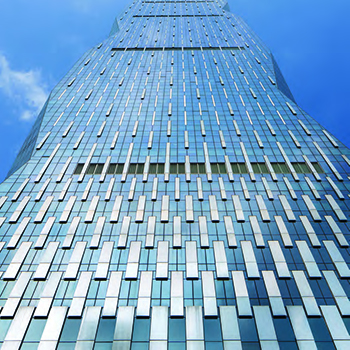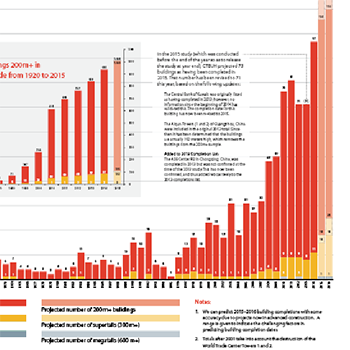Height rank
R&F Yingkai Square
Guangzhou
-
Metrics
You must be a CTBUH Member to view this resource.
Official Name
R&F Yingkai Square
Other Names
Park Hyatt Guangzhou
Type
Building
Status
Completed, 2014
Country
City
Address
Postal Code
510000
Function
A mixed-use tall building contains two or more functions (or uses), where each of the functions occupy a significant proportion of the tower's total space. Support areas such as car parks and mechanical plant space do not constitute mixed-use functions. Functions are denoted on CTBUH "Tallest Building" lists in descending order, e.g., "hotel/office" indicates hotel function above office function.
residential / hotel / office
Structural Material
Both the main vertical/lateral structural elements and the floor spanning systems are constructed from steel. Note that a building of steel construction with a floor system of concrete planks or concrete slab on top of steel beams is still considered a “steel” structure as the concrete elements are not acting as the primary structure.
Reinforced Concrete
Both the main vertical/lateral structural elements and the floor spanning systems are constructed from concrete which has been cast in place and utilizes steel reinforcement bars.
Precast Concrete
Both the main vertical/lateral structural elements and the floor spanning system are constructed from steel reinforced concrete which has been precast as individual components and assembled together on-site.
Mixed-Structure
Utilizes distinct systems (e.g. steel, concrete, timber), one on top of the other. For example, a steel/concrete indicates a steel structural system located on top of a concrete structural system, with the opposite true of concrete/steel.
Composite
A combination of materials (e.g. steel, concrete, timber) are used together in the main structural elements. Examples include buildings which utilize: steel columns with a floor system of reinforced concrete beams; a steel frame system with a concrete core; concrete-encased steel columns; concrete-filled steel tubes; etc. Where known, the CTBUH database breaks out the materials used in a composite building’s core, columns, and floor spanning separately.
composite
Height
296.2 m / 972 ft
Floors Above Ground
66
Floors Below Ground
5
# of Hotel Rooms
185
# of Elevators
29
Top Elevator Speed
6 m/s
Tower GFA
142,956 m² / 1,538,766 ft²
-
By function
You must be a CTBUH Member to view this resource.
-
By material
You must be a CTBUH Member to view this resource.
Architect
Usually involved in the front end design, with a "typical" condition being that of a leadership role through either Schematic Design or Design Development, and then a monitoring role through the CD and CA phases.
MEP Engineer
The Design Engineer is usually involved in the front end design, typically taking the leadership role in the Schematic Design and Design Development, and then a monitoring role through the CD and CA phases.
Other Consultant
Other Consultant refers to other organizations which provided significant consultation services for a building project (e.g. wind consultants, environmental consultants, fire and life safety consultants, etc).
Other Consultant refers to other organizations which provided significant consultation services for a building project (e.g. wind consultants, environmental consultants, fire and life safety consultants, etc).
You must be a CTBUH Member to view this resource.
Owner/Developer
Guangzhou R&F Properties Co., Ltd.
Architect
Usually involved in the front end design, with a "typical" condition being that of a leadership role through either Schematic Design or Design Development, and then a monitoring role through the CD and CA phases.
Usually takes on the balance of the architectural effort not executed by the "Design Architect," typically responsible for the construction documents, conforming to local codes, etc. May often be referred to as "Executive," "Associate," or "Local" Architect, however, for consistency CTBUH uses the term "Architect of Record" exclusively.
Guangzhou Residential Architectural Design Institute
Structural Engineer
The Design Engineer is usually involved in the front end design, typically taking the leadership role in the Schematic Design and Design Development, and then a monitoring role through the CD and CA phases.
Guangzhou R&F Properties Co., Ltd.
MEP Engineer
The Design Engineer is usually involved in the front end design, typically taking the leadership role in the Schematic Design and Design Development, and then a monitoring role through the CD and CA phases.
Main Contractor
The main contractor is the supervisory contractor of all construction work on a project, management of sub-contractors and vendors, etc. May be referred to as "Construction Manager," however, for consistency CTBUH uses the term "Main Contractor" exclusively.
The main contractor is the supervisory contractor of all construction work on a project, management of sub-contractors and vendors, etc. May be referred to as "Construction Manager," however, for consistency CTBUH uses the term "Main Contractor" exclusively.
Guangzhou R&F Properties Co., Ltd.
Other Consultant
Other Consultant refers to other organizations which provided significant consultation services for a building project (e.g. wind consultants, environmental consultants, fire and life safety consultants, etc).
Other Consultant refers to other organizations which provided significant consultation services for a building project (e.g. wind consultants, environmental consultants, fire and life safety consultants, etc).
Steve Leung Design Group Limited; Super Potato
ACLA
CTBUH Initiatives
CTBUH Releases Year in Review: Tall Trends of 2014
31 December 2014 - CTBUH Journal
Videos

16 September 2014 | Guangzhou
Blades of Steel: Understanding the Limits of Metal Façade Design
Metal claddings frequently skin our tall buildings. They provide the texture and shine that help distinguish one glass tower from the next. Like the fabric...
Research

17 October 2016
From Meadows to Megacities: Creating Urban Density in the Pearl River Region
Travis Soberg, Goettsch Partners
The Greater Pearl River Delta region emerged as a result of China’s 1979 reform policies. Within the last 20 years, the GPRD has grown from...
About R&F Yingkai Square
Located in Guangzhou’s new main central business district, R&F Yingkai Square stands within the city’s tallest cluster of towers. The rectilinear footprint of the tower aligns with the adjacent street grid and defines the open spaces between it and the neighboring buildings as a collection of urban rooms leading to a large central green space covering the roof of large subterranean mall at the center of the district.
The design of R&F Yingkai Square was inspired by the segmentation of Chinese bamboo, with notched corners at alternating heights creating a zigzag pattern over the height of the tower and adding complexity to an otherwise simple form. The tower has a highly textured façade featuring a pattern of stainless steel and glass which begins with a metallic base and transitions into a predominately glass exterior.
Further enhancing the visual segmentation of the tower’s façade are the visible grates of the mechanical floors, creating a external expression of the five components of the tower’s functions as it rises from the ground. These individual sections are comprised of retail, office and hotel spaces as well as residential apartments and duplex condominiums at the very top.
The base of R&F Yingkai Square setback from the adjacent streets with a landscaped plaza garnished with rows of trees, responding to the context of two intersecting arterial roads, placing the tower in a highly visible location and positioning it as a gateway building to the larger business district.
Research

17 October 2016
From Meadows to Megacities: Creating Urban Density in the Pearl River Region
The Greater Pearl River Delta region emerged as a result of China’s 1979 reform policies. Within the last 20 years, the GPRD has grown from...

31 December 2014
Year in Review: Tall Trends of 2014
An All-Time Record 97 Buildings of 200 Meters or Higher Completed in 2014 and 2014 showed further shifts towards Asia, and also surprising developments in...
Subscribe below to receive periodic updates from CTBUH on the latest Tall Building and Urban news and CTBUH initiatives, including our monthly newsletter. Fields with a red asterisk (*) next to them are required.
View our privacy policy


































